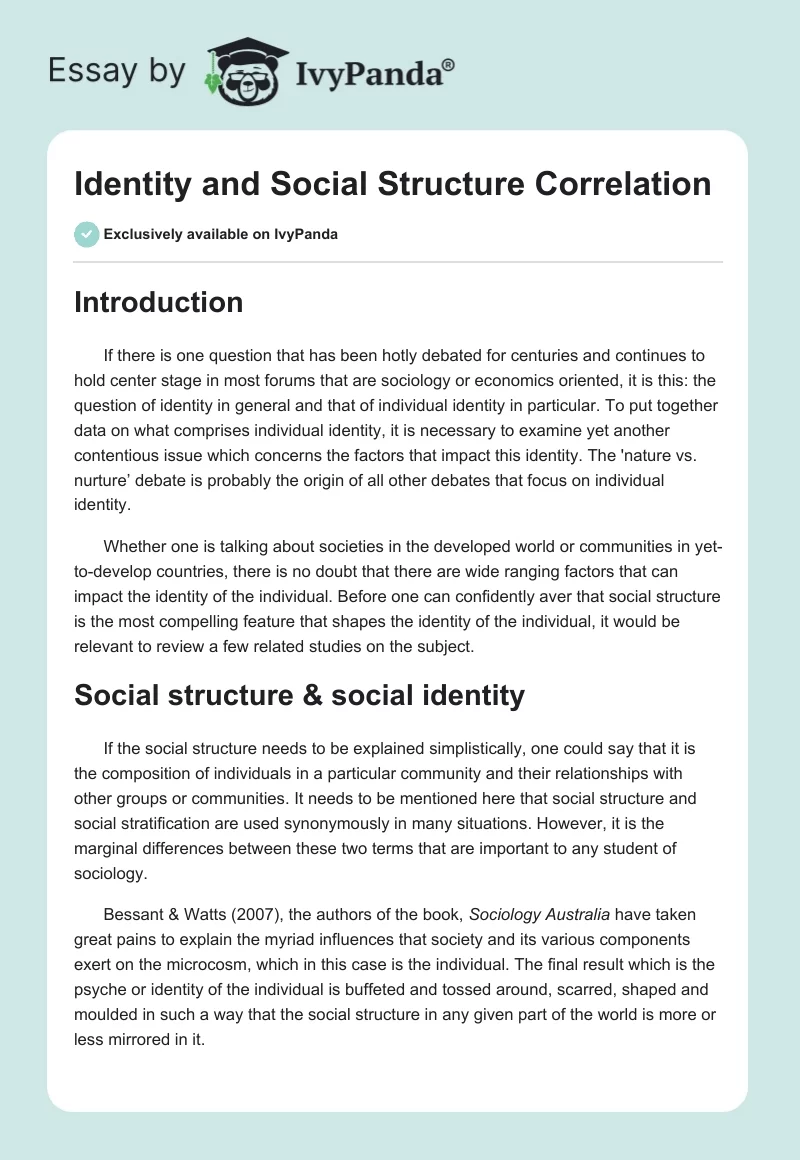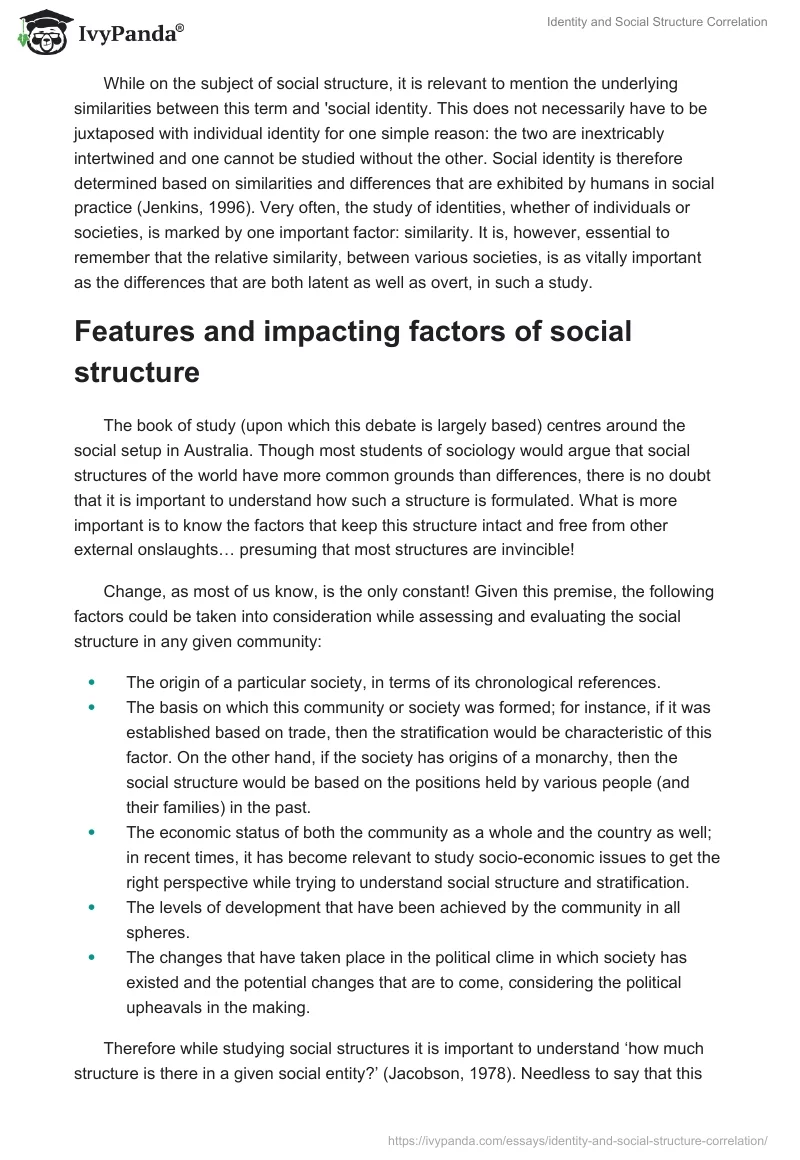Introduction
If there is one question that has been hotly debated for centuries and continues to hold center stage in most forums that are sociology or economics oriented, it is this: the question of identity in general and that of individual identity in particular. To put together data on what comprises individual identity, it is necessary to examine yet another contentious issue which concerns the factors that impact this identity. The ‘nature vs. nurture’ debate is probably the origin of all other debates that focus on individual identity.
Whether one is talking about societies in the developed world or communities in yet-to-develop countries, there is no doubt that there are wide ranging factors that can impact the identity of the individual. Before one can confidently aver that social structure is the most compelling feature that shapes the identity of the individual, it would be relevant to review a few related studies on the subject.
Social structure & social identity
If the social structure needs to be explained simplistically, one could say that it is the composition of individuals in a particular community and their relationships with other groups or communities. It needs to be mentioned here that social structure and social stratification are used synonymously in many situations. However, it is the marginal differences between these two terms that are important to any student of sociology.
Bessant & Watts (2007), the authors of the book, Sociology Australia have taken great pains to explain the myriad influences that society and its various components exert on the microcosm, which in this case is the individual. The final result which is the psyche or identity of the individual is buffeted and tossed around, scarred, shaped and moulded in such a way that the social structure in any given part of the world is more or less mirrored in it.
While on the subject of social structure, it is relevant to mention the underlying similarities between this term and ‘social identity. This does not necessarily have to be juxtaposed with individual identity for one simple reason: the two are inextricably intertwined and one cannot be studied without the other. Social identity is therefore determined based on similarities and differences that are exhibited by humans in social practice (Jenkins, 1996). Very often, the study of identities, whether of individuals or societies, is marked by one important factor: similarity. It is, however, essential to remember that the relative similarity, between various societies, is as vitally important as the differences that are both latent as well as overt, in such a study.
Features and impacting factors of social structure
The book of study (upon which this debate is largely based) centres around the social setup in Australia. Though most students of sociology would argue that social structures of the world have more common grounds than differences, there is no doubt that it is important to understand how such a structure is formulated. What is more important is to know the factors that keep this structure intact and free from other external onslaughts… presuming that most structures are invincible!
Change, as most of us know, is the only constant! Given this premise, the following factors could be taken into consideration while assessing and evaluating the social structure in any given community:
- The origin of a particular society, in terms of its chronological references.
- The basis on which this community or society was formed; for instance, if it was established based on trade, then the stratification would be characteristic of this factor. On the other hand, if the society has origins of a monarchy, then the social structure would be based on the positions held by various people (and their families) in the past.
- The economic status of both the community as a whole and the country as well; in recent times, it has become relevant to study socio-economic issues to get the right perspective while trying to understand social structure and stratification.
- The levels of development that have been achieved by the community in all spheres.
- The changes that have taken place in the political clime in which society has existed and the potential changes that are to come, considering the political upheavals in the making.
Therefore while studying social structures it is important to understand ‘how much structure is there in a given social entity?’ (Jacobson, 1978). Needless to say that this structure does not exist from one era to the next, without exhibiting some change or the other! For instance, if one were to go into a study of the social structure in a country like Afghanistan, it would be difficult to even imagine the complete turnaround that has happened in the last century.
From being moderate thinkers, capable of understanding and appreciating the diversity of other communities (could be read as, ‘other religions’) the Afghans have been forced to perceive life in their country through the eyes of fundamentalist regimes. Therefore, if one were to talk about structure in this kind of a social entity, it would be pointless to do so, without doing a thorough study on the road that societies travel in times of political ups and downs.
The individual
Assumptions are probably the most potent of all the weapons that a sociologist could wield. It is possible for anybody who is studying the multifaceted identity of an individual to develop certain paradigms and hope that most individuals fall into these preset stereotypes, thereby making studies easier and more objective. This approach could never constitute a thorough study; for one simple reason – it would be far too simplistic and far from multi-dimensional. A student of sociology would therefore understand right at the very beginning the importance of having more than just one or two perspectives. One could argue that basic premises have to be set to make a study more effective and this is what this essay seeks to do.
At the cost of sounding repetitive, it is important to hearken back to the ‘nature vs. nurture debate. A study on individual identity would be far from complete if this particular debate was not discussed and brought into the picture. Over the last few decades, there have been various scientists who have explored the genetic structure of the homo sapiens species and produce results that have made this debate more complex.
Some social scientists believe that the debate itself is a “false dichotomy” (Ridley, 2004). Is it possible, Ridley (2004) asks, to separate one from the other? There is such a thin and fast-disappearing line that is based on what the person is and how the environment he lives in, shapes him; hence, to conclude what accounts for the identity of the individual is a question that has far too many answers. The 30000 genes that exist in a human body could be studied, till the whole subject is threadbare, but there will be so many more factors that impact the identity of the individual. Here, one comes to the most difficult-to-accept aspect of the debate – does the social structure play an all-important role in shaping the identity of a person or for that matter, a group of persons?
The identity question
Since the identity of the individual is so fraught with ifs, buts and maybes, a historical perspective is sought to throw some clear light on the subject. In times of change in the developing world, when the word identity is virtually over-used in more spheres than one, the study of histories of various social structures, helps one get an idea of how and why individual identity is ‘almost entirely the product of social structure’. This is particularly true while learning more on the subject of gender identity. Though Greig, A., Lewins, F. & White, K. (2003) would like to dwell more on inequality, their study helps understand the intricacies of identities in a fast-changing world, in this case, Australia.
While putting together facts in support of the argument that social structure and overall stratification are the most forceful factors that impact individual identity, the concept of ‘sociological imagination’ cannot be ignored (Mills, C W 1959). He was one of the earliest social scientists to put together the key elements of the value system, the resulting social structures and thereafter the individual’s place (or identity) within.
Cognitive changes and the motivation of the same in an individual is also said to be directly related to changing social structures. The idea of the ‘social self’ is an expression of the quest of everyone for his or her identity. Sometimes, the identity takes on a different hue and shape based on the intensity of interpersonal relationships on the one hand and the social environment at a given time. (Forgas, 2001). Aping is a trait that is found in most primates and humans are no exception. Identities are formed, broken and re-formed because of these affectations; these finally become integral parts of the psyche of an individual.
No study on identity is complete without mentioning an important aspect of social psychology – discrimination and intergroup behaviour. It is this aspect that forms the foundation of further exploration into the subjects of racism and prejudice, which are another two key factors that can shape individual identity. Intergroup behavioural patterns are studied to throw more light on this aspect (Sedikides, C. Insko, C.A. & Schopler, J. 1998); the trustor distrust between similar or diverse social groups have a bearing on the identity of the individual in a particular group.
Conclusion
To understand the peculiarities of a country like Australia, references to other developed countries or democracies, would certainly not be misplaced. Tiffen and Gittins (2004) try to put together a large amount of data, covering a wide span of subjects, which helps get a good insight into individual identities in this part of the world. Political, social, cultural, and economic factors need to be considered while trying to discern the level of influence, social structure exerts on an individual’s identity.
The rapidly changing social structure is difficult to study and categorize, mainly because of the economic changes that are being wrought not just in Australia, but all over the world, as well. Bessant & Watts (2007) try to open up as many trains of thought, on the issue, hoping that the answer will be a comprehensive one that prepares any student of sociology with the opportunity to be informed about the pulls and pushes, an individual is subjected to.
References
Bessant, J. & Watts, R. (2007). Sociology Australia. Crowsnest, NSW: Allen & Unwin.
Forgas, J. P. (2001). Affect and “Social Mind”: Affective Influences on Strategic Interpersonal Behaviors. In J.P. Forgas, K.D. Williams & L. Wheeler (Eds.) The Social Mind: Cognitive and Motivational Aspects of Interpersonal Behavior. U.K.: Cambridge University Press.
Greig, A., Lewins, F. & White, K. (2003). Inequality in Australia. U.K.: Cambridge University Press.
Jacobson, D. (1978). Scale and Social Control. In F. Barth (Ed.) Scale and Social Organization. (p. 223). Oslo: Universitetsforlaget.
Jenkins R. (1996). Social identity. London: Routledge.
Mills, C.W. (1959). The Sociological Imagination. New York: Oxford University Press.
Ridley, M. (2004). The Agile Gene: How Nature turns on Nurture. New York: Harper Perennial.
Sedikides, C. Insko, C.A. & Schopler, J. (1998). Intergroup Cognition and Intergroup Behavior: Towards a Closer Union (Applied Social Research) (Applied Social Research Series). Mahwah, N.J.: Lawrence Earlbaum Associates.
Tiffen, R. & Gittins, R. (2004). How Australia Compares. U.K.: Cambridge University Press.


